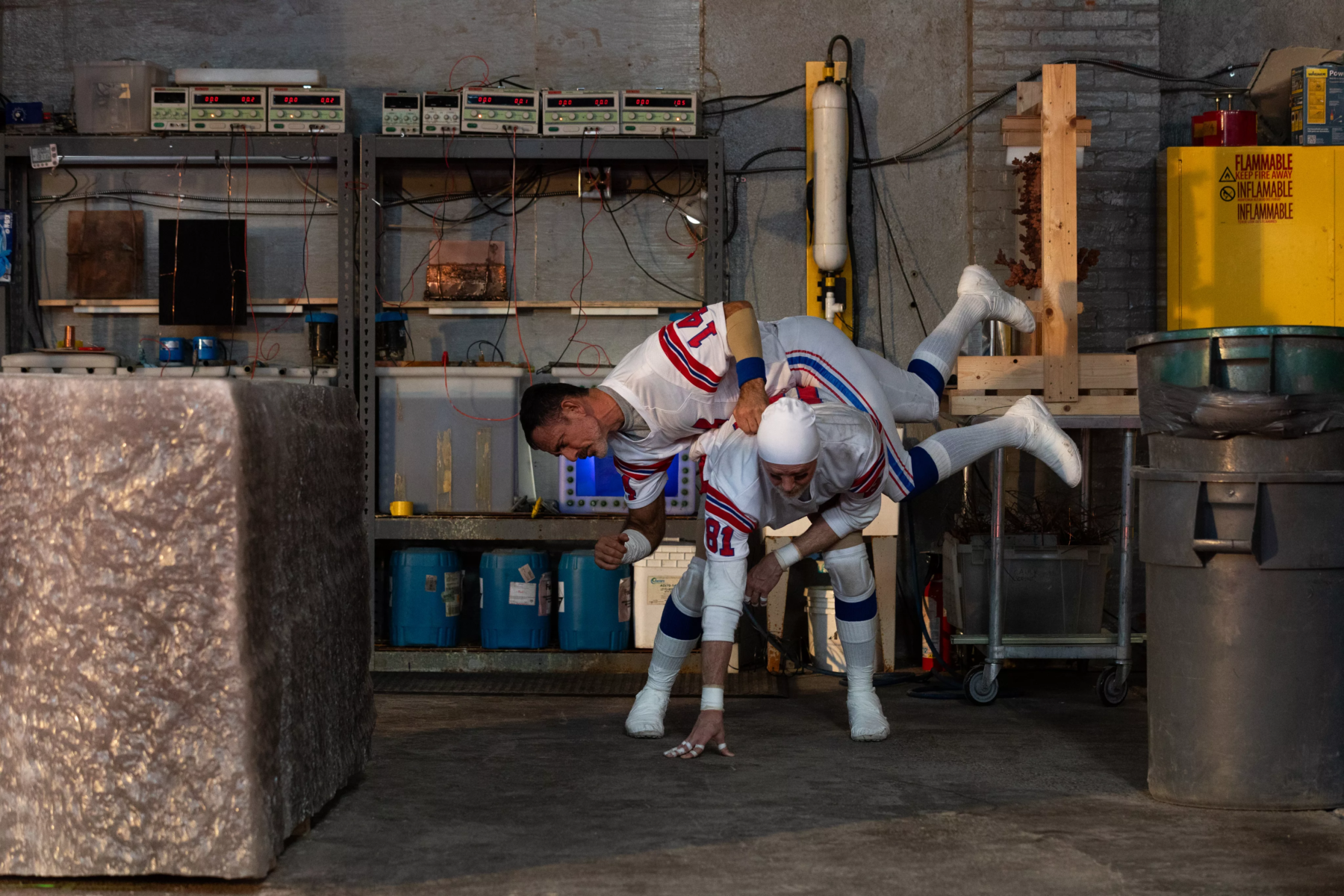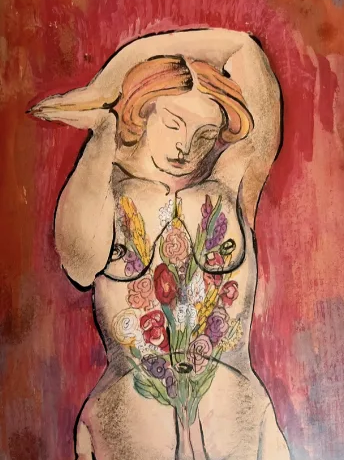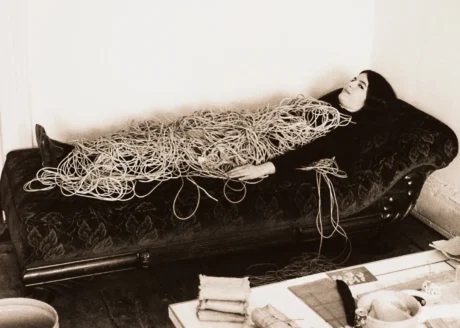In this piece Bella Butler explores the significance of ‘site’ in artist Matthew Barney’s most recent work Secondary (2023) and considers the role of the exhibition spaces in relation to the art they hold. She considers the question: what does it mean for an exhibition to move locations?
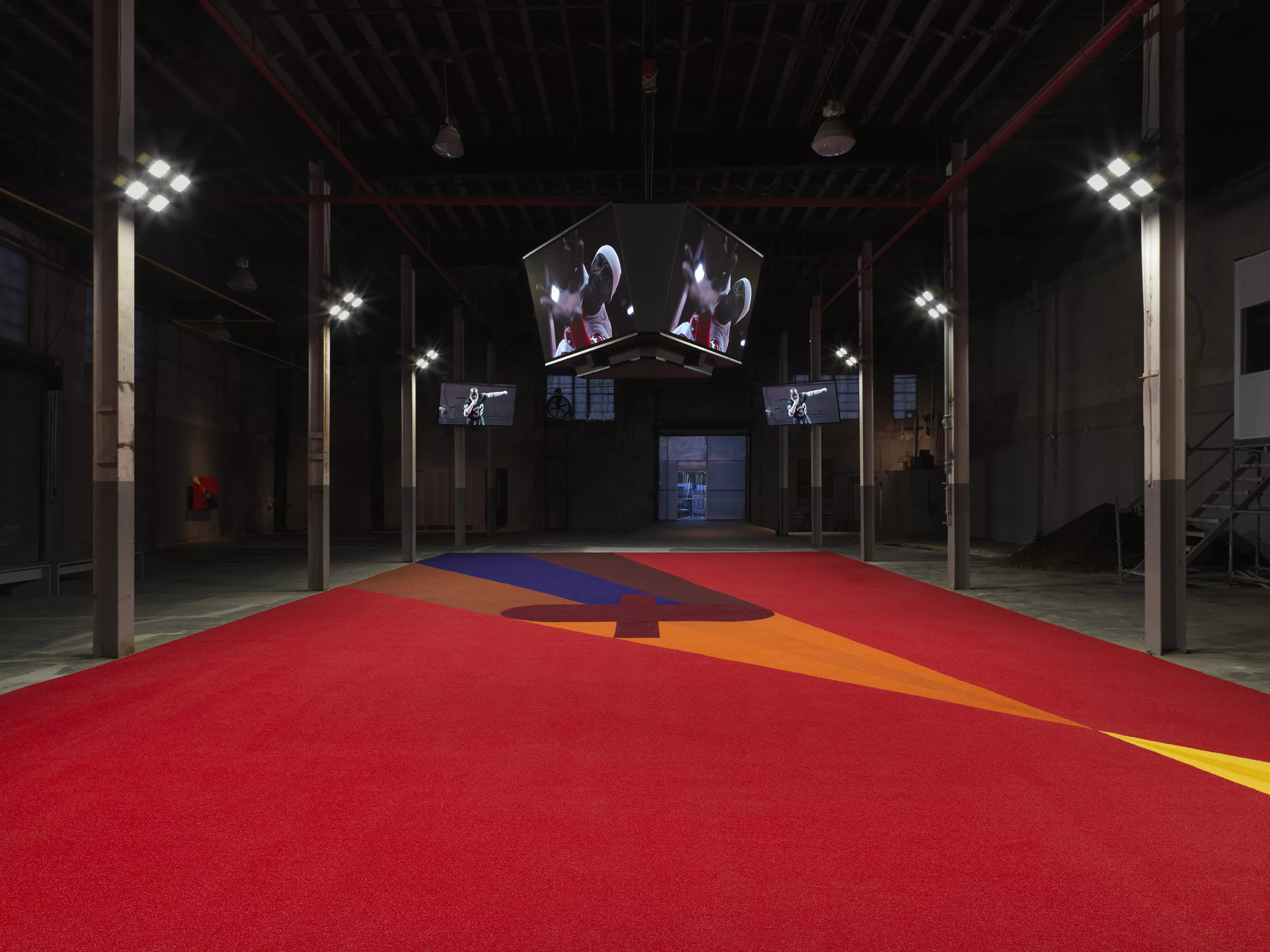
The concept of ‘site’ in relation to art can be entirely straightforward: it is a framework of thought that acknowledges that everything on our earth takes place in time and space. Matthew Barney’s show Secondary (2023) overtly confronts issues of site, namely (but not solely) by displaying his film in the very location, the very building it was shot in. The site is the piece and the piece is the site.
Secondary (2023) is a five-channel installation of a one hour film (the clock time of a football game) which Barney made with the help of a cast of 11 others (including himself). The film was initially a response to a tragic event in American football history: on August 12, 1978, Darryl Stingley of the New England Patriots was left paralyzed by an open field hit from Oakland Raiders’ player Jack Tatum. The film runs on a loop and is situated within raw warehouse walls: crumbling brick, concrete, and lack of natural light.
Secondary (2023) contains familiar motifs present in many of Barney’s other works: masculinity, pain, the body as both living thing and object, violence, and of course, the sport of American football (which Barney himself was recruited for as an undergraduate at Yale University). But this game, and football itself, is only a skeleton for Barney’s piece, a performance that explores the body’s relationship to structural space as well as the ‘space’ of the bodies of others. While the event at hand is a specific one, it is exemplary of one broader principle relationship between bodies and their space: collision. What does it mean to touch another body, to touch another’s space, with such force, that it destroys you? What does it mean that this act of touch is at once fundamental in the act formation (creation) as well as deformation (destruction)?
And what does it mean that we like to watch it?

When I arrived at Secondary’s original home, Barney’s studio in Long Island City, I was greeted outside the building by two smiling young people, eager to give me my audience-instructions. They handed me a program of sorts, an offering. We were required to wait a short period of time, as the installation (hence not merely being an installation) was time-based, on the hour. When it was time to enter, we walked through a curtain of thick plastic ribbons (carwash-esque) and into the shockingly large space of the warehouse. The big rectangle of turf, intended to simulate a football field, was in the middle of the space, with the five screens mounted above and around, in a similar manner to the screens present at large sporting events. I was in the game (or in the piece?).
But as much as my eyes were drawn to the spectacle of the film and colorful turf, my hands, feet and limbs were as attracted to the rest of the warehouse space. There was dust, rock, concrete, bricks, and of course a gaping trench off to the left (stage left?) with water and exposed ceramic pipes. A haptic and noisy daydream (or nightmare). And while the sounds were narratively derived from the film, they had a presence in the space independent from the screen. In fact, they relied on the space to gather strength. Or rather: they were coming from the space itself, as a result of having been physically made there by the cast and artist. This fact was reinforced by the visual image of the screens and the filmic representation of the space they portrayed, placed against the backdrop of the very same space. It was an almost self-reflexive relationship, both elements referring and motioning to the vitality of the other through their auras. It was an active environment, artistic ecosystem even, which prompted the free movement of audience members. In this way, it was a reactive environment between bodies and things, and things with traces of body. I wanted to make those sounds too. I wanted to produce something from the impact of my body and materials meeting.
The closest I got was sort of crawling around on the turf and engaging in a kind of close-eyed displacement of myself at times.
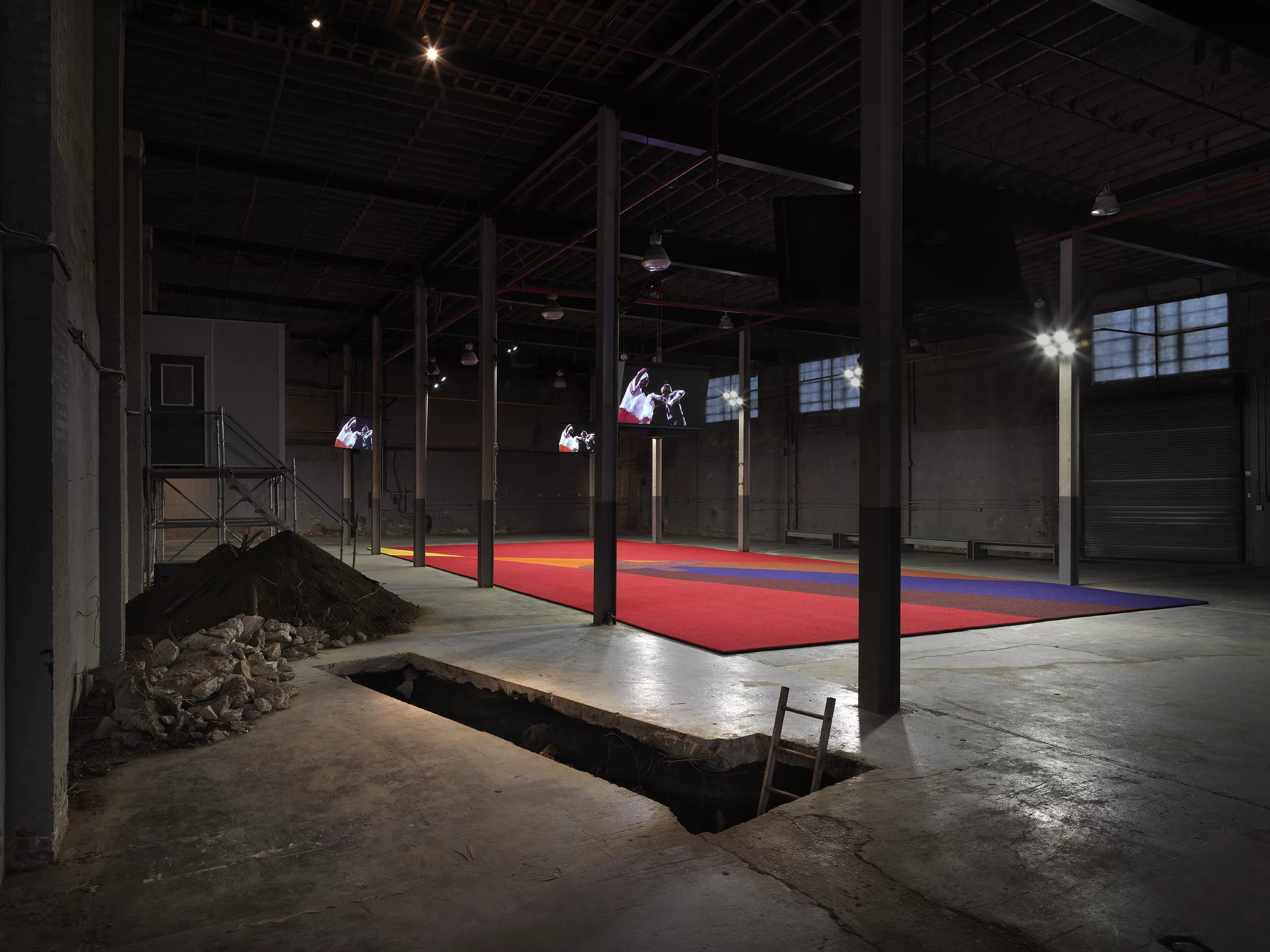
A year later I find myself in Sadie Coles HQ gallery in SoHo, London, standing in a beautiful open room, filled with white light, faced with Secondary once again. It is an accident, but a happy one.
So, I attempt to settle in (first standing and then sitting) and let the grunts and cries from the film wash over me. The work still has oomph—it is hard to escape oomph from a Barney work—but something feels different. I feel some physical discomfort. I have a hard time choosing where to position myself because I feel deeply self conscious in front of the other gallery attendees (relative to my lack thereof in 2023).
Back in 2023, in Barney’s studio, I had taken off my shoes, put my bag down, and walked barefoot around the dark cavernous space, seduced by the texture and spring of the colorful turf “field” or arena which the large number of screens were placed around. But in the gallery in London, my shoes are very much on and my bum never touches the turf. In fact, I spend most of that accidental second viewing on one of the benches that were positioned outside of the turf at the edges of the rectangular room of the gallery. Why is my comportment all out of sorts the second time around? What has changed? The simple answer is: site.
Secondary (2023) has gone from Barney’s gritty studio to a gallery in the heart of London. (And now to Paris.)

In an interview for the New York Times back in May of 2023, Barney notes that the studio, the space, is “the organizing body for this story.” In fact, in the article, he states forthright, “I wanted my working space to be character.”
Reviews of Secondary (2023), refer to it as a film or an installation. And yes, its central element is a film; yes, it is an installation insofar as there are ‘installed components.’ But to merely regard it as such ignores the significance of the site, the building itself, that is responsible for holding the five-channel-installation. I would argue that, when it was located in Barney’s studio, Secondary (2023) was a site-based performance more than anything. It was a performance that prompted viewers to instead be audience members, audience members who take off their shoes, walk around and gaze into giant trenches in the middle of the room (Barney dug a trench in his studio which hit an old ceramic pipe, welcoming water with varying levels of fullness, depending on the tide of the East River). Within the walls of a London gallery, Secondary it feels cleaner, contained, and unable to transform gallery viewers into gallery audiences.
The distinction between an audience member and a viewer might come across as trivial, but on the contrary: it has everything to do with site, with space. A viewer is defined (linguistically) by their access to one sense: sight. The rest of their body melts away. Because of this, spatially there is infinite distance between themselves and the thing which they are seeing. The audience member, however, is not necessarily restrained in their senses. The only separation between themselves and the thing which they are experiencing (show, performance, etc.), is theoretical and ideological. The audience member is granted sight, touch, smell, and proprioception. The spatial “rules” of audience-ship are dictated by the creator of the piece.

The shift from audience member to viewer, from movement to stillness, and from touching to virtually limb-less, to me, can only be explained by the exhibition’s change in site (and change in sight): the body holding the show.
As many architects and artists throughout history have believed, space can be thought of as body, as organism, with anthropomorphised qualities, i.e. walls as membrane or skin. But in keeping with this metaphor, not all spaces are the same.
The gallery space is the kind of character who has a body and a name (usually the name of a human, see: Sadie Coles) but lacks vital organs. This may seem alarming: what will a body do without internal organs? Well, the answer is simple: borrow from the bodies of others. In my metaphor, the body is the artist, and the organs are their art. Gallery spaces have a longer lifespan than a human body, precisely because they have no organs. Precisely because they are regularly receiving transplants from the bodies of artists. It keeps them alive. They are an infinite body of sorts. This is the “site” of the modern day gallery. It is not worse than Barney’s studio, but different.
Secondary (2023) in Barney’s studio was a fully functioning being, the organs of the installation still tethered by invisible veins and muscle tissue to the walls of the studio’s body, the skin of the studio’s body. Secondary’s departure from its original body, however, was inevitable. The building was soon to cease in its physical existence as Barney’s space, and its artistic organs would have died with it had it not been transplanted between new walls. In this way, the body of the capital G “Gallery” has provided a safe haven—and in turn, Barney’s work has provided the Gallery with vitality.

But Secondary (2023) is leaving the body of Sadie Coles Gallery on August 17th and it has just moved to Paris where it will be hosted by the walls of Fondation Cartier and open to the public until September 8th. And, because I clearly can’t get enough of these exhibition transplants, I followed it there, to see what sensations and emotions the new body of Secondary (2023) would arise in me.
The Fondation Cartier building in Paris looks like the lovechild of a modern glass structure and an old industrial building. It is an intriguing piece of architecture that has been seemingly dropped among the old iconic apartment buildings of the city and yet it is easy to miss because it is hidden by an urban jungle of sorts (yes!). Because of this, the site itself feels integral to any show that it is hosting. And in the case of Secondary, this is certainly so. Notably, during my visit I began to experience the piece before I even walked in the door. Hence: the glass building. As Juliette Lecorne, the brilliant curator of the show, walked me around the outside of the building, I was able to watch people watching. The transparent body of this gallery gave the feeling that it was under an x-ray, in the sense that you could see through its skin all the way to its bones and organs—its vitality—without even entering. It made a spectacle of the concept of “spectacle,” a concept integral to the piece as well as to the relationship between American football (or sports) and the culture of viewership more broadly.
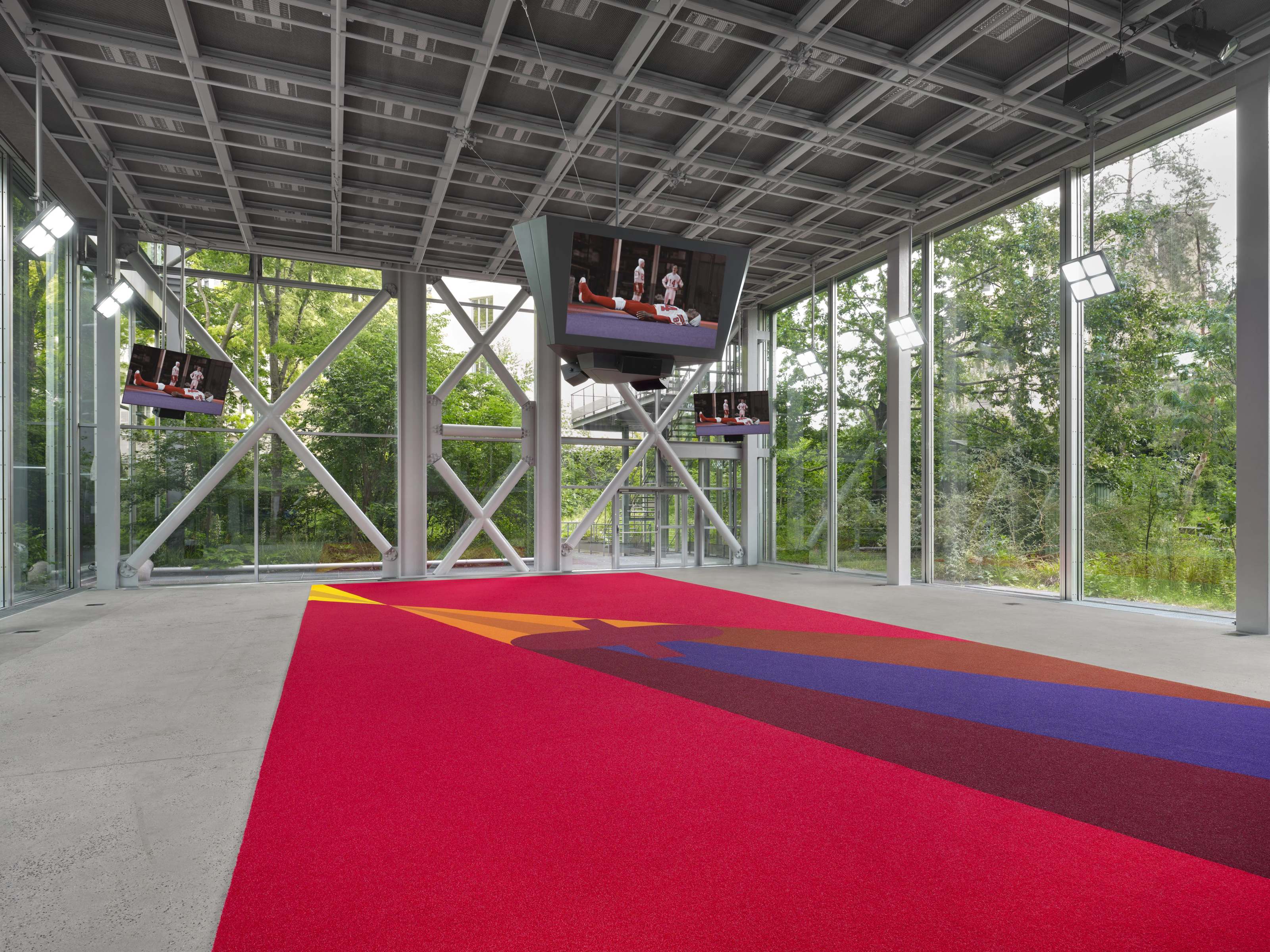
It also made one keenly aware of the permeability of theoretical spaces, the inability for any space to truly be self-contained. This was brought to my attention as Juliette motioned to the grassy areas surrounding the building and shared with me that Barney thought of the gardens surrounding as a kind of extension of the football field that the turf on the inside represents. The American football field, the battle-ground of sorts, as a symbolic space that ideologically reaches far beyond its physical boundaries.
Site and sight: inseparable and symbiotic. I urge you when attending Secondary (2023) to observe yourself, your own body, within whichever body-of-space you are seeing it. What does it mean to be one body watching, hearing, feeling, other bodies colliding on a screen? What does it mean for a body of space to hold vital organs that portray both a site (and sight) of violence: the football field? What does it mean to sit on a plush couch within your home and watch a sport—an organized amalgamation of bodies—in which the body engages in self-destruction? How does our sight reinforce the site? Barney’s traveling Secondary provides a drawn out meditation on site and sight and most radically, the changes that they prompt in one’s comportment, one’s physical movements in space.
Words by Bella Butler
